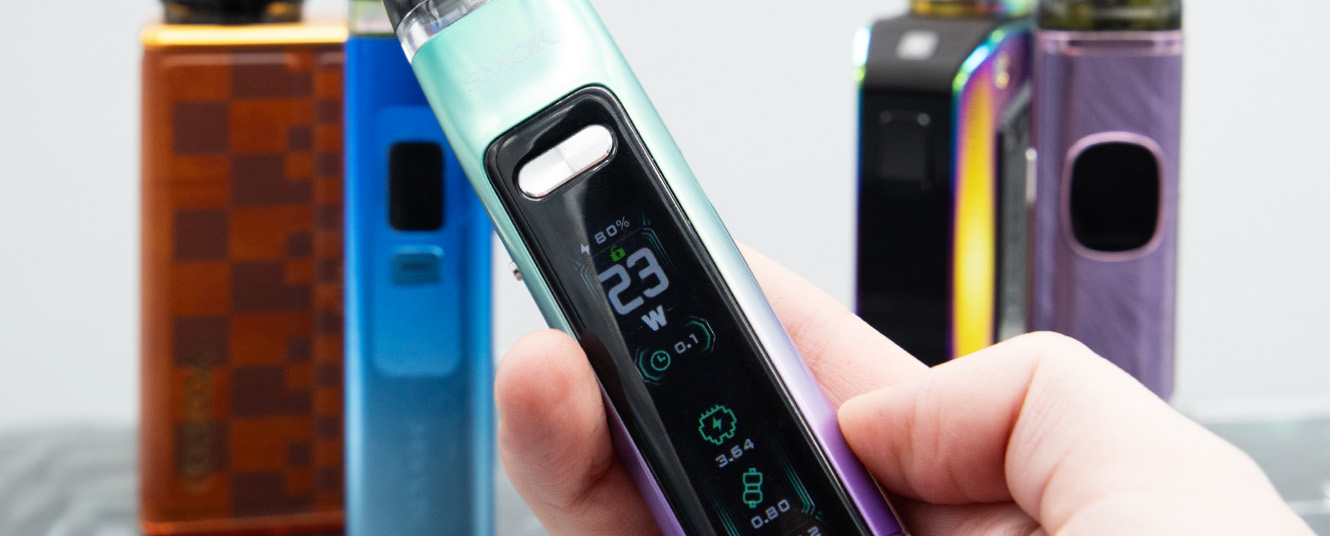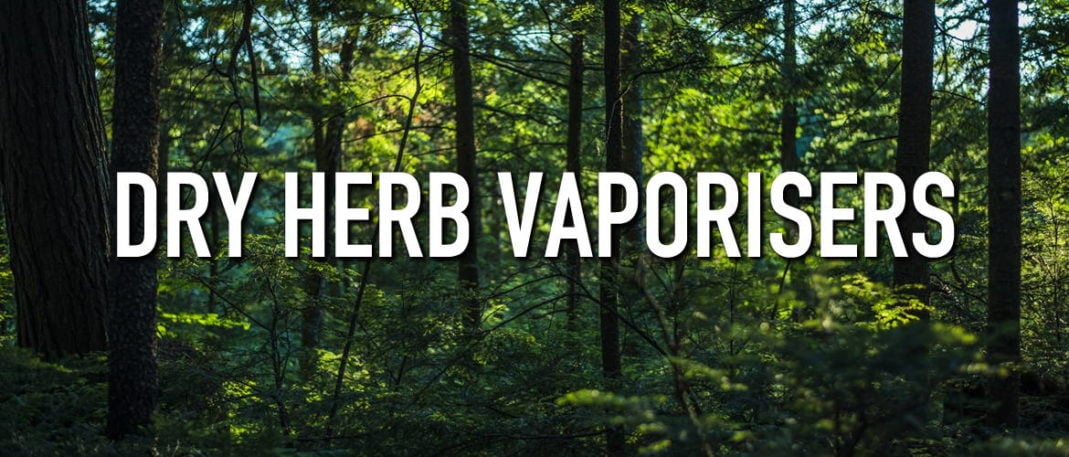The wattage you vape at can have a big effect on the quality of your overall experience. While most starter kits will make it easy for you to make sure you’re always vaping at the correct wattage for the device, there’s also a lot of freedom to make adjustments to suit your preferences, especially on intermediate or advanced kit.
Want to know what wattage you should vape at to match your preferences and make the most of your experience? Be sure to check out our comprehensive guide.
Understanding vape wattage
Vape wattage describes the power output of a vaping device – the higher the wattage, the more power available. The wattage is used to heat your coil, which in turn is instrumental in heating your e-liquid and producing vapour. Many modern vape kits make it possible for you to adjust the power output of your vape, allowing you to use a lower or higher wattage depending on your preference.
When you’re looking to perfect and customise your vaping experience, the wattage is one important element to keep in mind. The wattage you vape at can have a few different effects on the device, ranging from the type of vapour you produce to how long your coil is likely to last.
Why is choosing the right wattage important?
Being able to choose your own wattage is a great way to personalise your vaping experience. But, it’s also important to understand how the wattage can affect the life of your vape’s components.
How wattage changes your vaping experience
- The wattage you vape at can change the flavour intensity you experience. For example, at very high or low wattages, you may find that your flavours are muted or degraded
- Vapour clouds are also affected by the wattage used. The higher the wattage, the bigger the cloud
- Wattage also affects temperatures, with lower wattages associated with cool vapour clouds and high wattages producing a warmer cloud
How different wattages can affect your vape
- Using a wattage that’s too high can cause the cotton in the coil to burn out straight away, or at a much faster rate than usual
- An overly high wattage can also sometimes cause the vape itself to warm up, or even to overheat
- Consistently using a high wattage can also impact the lifespan of your battery, meaning it might not last as long as it would otherwise
- Conversely, using a wattage setting that is too low can mean e-liquid is not vaporised quickly enough, causing the e-liquid to flood the coil and leading to gurgling, spitting, and leaking
Ultimately, using the wrong wattage can lead to issues like burnt coils, reduced device lifespan, and poor flavour. However, adjusting the wattage to suit your vaping preferences can also allow you to enjoy a more personalised experience.
Key factors that influence vape wattage selection
So, how do you decide which wattage to use? Check out some handy information to help you select the ideal wattage range that also ties in with your personal preferences.
Coil resistance
The type of coil that your device contains is the main deciding factor when it comes to the ideal wattage. Coils have a certain amount of resistance, which is measured in ohms. This resistance lets you know how easily electricity can flow through the coil and how much power is needed for it to reach the desired temperature. So a low resistance coil (often called a sub-ohm) require higher wattages, while high resistance coils work with lower wattages.
Each coil has a recommended wattage range that’s been provided by the manufacturer. You should find this on the box or, sometimes, on the coil or pod itself. This information lets you see the settings that will allow your coil to work at its best. The fact it’s a range gives you room to experiment and find which wattage within this range feels best to you.
E-Liquid composition: PG/VG ratios
The composition of your favourite e-liquids is another important factor. Vape juices contain varying levels of PG and VG, two of the main components of e-liquids. Liquids with a high VG concentration thrive at higher wattages, while those with a high PG ratio perform better at lower wattages. Unsurprisingly, 50/50 compositions fall somewhere in the middle!
So why do the concentration levels make a difference? It’s because PG and VG have different consistencies which mean they are better suited to particular coil resistances and therefore different wattage ranges.
VG is thicker and low resistance coils tend to be larger in size, making it easy for the big coils to absorb the thick e-liquid. VG is responsible for cloud production, so high VG e-liquids create a denser cloud and are best used in intermediate to advanced devices.
PG has a thinner consistency which is easy for the small coils with higher resistance to absorb without drying out between hits. 50/50 and high PG e-liquids are better suited to starter kits and simple pod kits. Find out more in our guide to PG and VG vape juices.
Personal preference
The other major factor to consider is your personal taste and which things you tend to prioritise when it comes to vaping. For example, do you enjoy a MTL (mouth-to-lung) experience or do you prefer DTL (direct-to-lung)? In which case, a higher wattage is often used for DTL vaping, while MTL is best served by lower wattage settings.
Or are you more focused on dense vapour than you are on flavour, or vice versa? If it’s a big vapour cloud you’re after, then a higher wattage is better.
A higher wattage setting is also best used with low nicotine strengths, while low wattages tend to work best for high nicotine strengths.
General vape wattage ranges and their effects
When it comes to vaping, there’s no one “perfect” wattage. As we’ve explained above, there are lots of different factors that come into play, including your personal preferences and the manufacturer’s guidelines. However, we have gathered together some handy information below, to offer a rough idea of which wattage might be best suited to which kind of desired experience.
Low wattage (7-15W)
A low wattage of 15W or under will produce a cool vapour and small clouds. The lower end of the wattage scale also tends to be ideal for beginners or anyone who enjoys MTL vaping.
Most starter kits and pod systems with a set wattage will have one within this range – or only slightly higher.
This is also the wattage range best used with CBD e-liquids because it ensures you can avoid burning the CBD and offers a better experience overall.
Medium wattage (15-40W)
With a medium wattage, you’ll enjoy a moderate vapour with a warmer feel. Vapes with wattages in this range are typically popular among intermediate users and there are a variety of intermediate devices that offer a set or variable wattage in this range, capping out at 30-40W.
High wattage (40W and above)
Vapes that have a high wattage range of 40W and above are great for people who enjoy large vapour clouds and hot vapour. They are best suited for DTL vaping and experienced vapers, and you’ll normally only find settings this high on advanced vape kits.
Higher wattage settings require a low resistance coil, so there will only usually be one or two coils compatible with the top of the wattage range. What’s more, most coils are not recommended for use over around 80W as this is simply too much power for the cotton to be able to handle for extended periods.
It’s also worth bearing in mind that low resistance/high wattage coils do not last as long as high resistance/low wattage coils, because they are subject to more heat which burns the cotton faster.
Recommended wattage by coil ohm level
Curious about which wattage levels will be most suitable for particular coils based on their ohm levels? Check out some handy information to help you make a decision, but always be sure to read the manufacturer’s recommendations too.
Each resistance (or ohm level) of a coil is suited to a particular wattage range, and its best for these to align when you’re looking to optimise your vaping experience. That said, there are a few other important factors to include alongside coil resistance, as the ideal wattage levels can also be determined by the coil’s design, size, the metal used for the coil, the thickness of the cotton and more.
0.2 ohm coil wattage
A 0.2 ohm level is considered a very low resistance coil and will usually only be available for advanced vapes, although you may find a few intermediate ones utilising these coils.
Wattage range for these coils would depend on the design of the coil, but you’d usually expect to see them used with a power output of around 60-80W.
0.4 ohm coil wattage
0.4 resistance coils are usually designed to be used with intermediate and advanced vapes, although the wattage levels can vary a lot.
The range will depend on the design of the coil – for example the Zeus coil has a large design and is used with advanced vapes, ideally with a 60-70W range, while the 0.4 XROS pod has a smaller coil and is used with intermediate vapes, ideally at 24-30W.
0.6 ohm coil wattage
As with 0.4 resistance coils, 0.6 coils are good for intermediate vapes and there’s a lot of variance in the suitable wattage levels. For example, the SMOK Novo 0.6 pod performs best at around 16 – 20W, while Vaporesso GTX mesh coils 0.6 are best at 20 – 26W.
0.8 ohm coil wattage
Likewise, the wattage range for 0.8 coils can vary a lot depending on the design, but you’ll find that they tend to be most commonly used in starter kits. A few examples are the Innokin Prism S coils 0.8, which are best at 16-18W, and Vaporesso GTX coils, which are best at 12-20W.
1.0 ohm coil wattage
Once you get to a 1.0 ohm rating, you’re most likely to see coils that are only available in starter kits. Typically those with a wattage of 17W or below.
1.2 ohm coil wattage
Similar to 1.0 ohm coils, you’re most likely to see 1.2 coils used in or compatible with starter kits with a wattage range of between 10-15W. Like the Innokin Zenith coils 1.2, which are best at 10-14W.
How to find your ideal wattage
While coil resistance is a handy factor to consider when you’re picking a wattage to start at, there are a few things you can think about when you’re on a journey to pinpointing your own preferred wattage. Here are some top tips to keep in mind.
Check manufacturer recommendations
The best place to start is with the manufacturer recommendations. Be sure to see what the vape and/or coil packaging says and use that as your baseline. Also, some devices offer a smart mode which will automatically sets the wattage to the power best suited to the detected coil – meaning you can let it make the decision for you.
To get a good idea of the way wattage can affect your experience, it’s also smart to start out low with a new coil and increase the power after an hour or so to ensure the coil is fully primed.
Start low and adjust gradually
Once you have your starting point, it’s a great idea to start at the lower end of the recommended range and slowly increase the wattage until you meet the desired experience.
Lots of vape devices make it possible for you to adjust the wattage in 0.5 increments, so you can control your increase.
Test and fine-tune
When you’ve had time to get used to the recommended wattage and have a good idea of how changes affect your overall enjoyment, you can start adjusting the wattage while paying attention to the way it changes vapour production, style, and throat hit until you find the combination that suits you best.
Common mistakes to avoid
It’s normal that when you start experimenting with various different wattages you may come up against some of the most common mistakes or issues. These are some of the ones that it’s good to look out for.
Using a wattage that’s too high
- Exceeding recommended manufacturer wattage can result in burnt coils and poor flavour, which can linger even after changing the coil
- Using a wattage that’s too high can also mean that you go through coils and batteries more quickly than intended
Using a wattage that’s too low
- Using too low a wattage can lead to coil flooding or underperformance
- This is because the e-liquid is not vaporised fast enough, leaving the coil to become over-saturated which can cause leaking, spitting, and gurgling
Using an incompatible e-liquid for your device wattage
- Using high VG in a starter kit can cause the coil to burn out very quickly, resulting in lots of dry hits and poor performance
- Using a 50/50 or high PG in an advanced kit can also cause leaking, spitting, gurgling
Vape wattage FAQs
What wattage level do common disposables use?
While the wattage used in disposable vapes can vary, most are around 10-12W, and they’re almost always below 20W.
What happens if I use the wrong wattage?
Using the wrong wattage can result in poor performance and a less than ideal vaping experience. For example, using a wattage that’s too high can result in burnt coils and unnecessary strain on coils and batteries in the long term. A wattage that’s too low could lead to coil flooding, leaking, spitting and gurgling.
Can I use the same wattage for all e-liquids?
No. For the best experience, you want to adjust the wattage depending on the e-liquid. So, a thicker e-liquid works best with a higher wattage and vice versa.
What’s the difference between MTL and DTL wattage requirements?
As a general rule, MTL (mouth-to-lung) will usually require a lower wattage and MTL devices will usually only offer a lower wattage range. On the other hand, DTL (direct-to-lung) is usually only available with intermediate/advanced devices which offer higher wattage, and a higher wattage offers a better vaping experience for DTL vaping.
Paying attention to wattage and experimenting with different levels (within safe limits) can help you customise your experience depending on the type of device, e-liquid and vapour cloud you prefer. Ready to start tailoring your experience? Explore our full range of vape kits today.




























